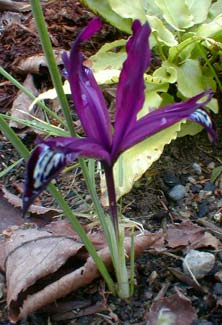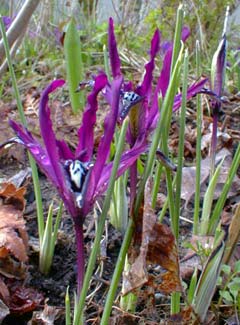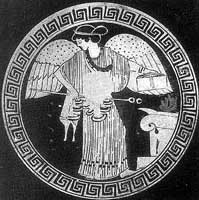
'Purple Gem'
Dwarf Beardless Iris; or,
Purple Rockgarden Iris
"Some hang above the tombs,
Some weep in empty rooms,
I, when the iris blooms,
Remember.
-Mary Coleridge
1861-1907
1861-1907
Iris reticulata is a dwarf iris grown from a small bulb. Native from the Caucasus Mountains to central Iran, it has been widely circulated among British & European gardeners since the earliest 1800s. All its varieties like full sun to bright or partial shade; grow to six inches height in flower (the grass gets taller after the flowers are finished); with mildly scented flowers early in the year.
 The natural color of the species is blue, but 'Purple Gem' has deep plum-purple standards with lighter veining. The three largest flower petals have yellow & white markings. The petels are so much slimmer than on most Reticulated Iris cultivars that it seems scarsely the same species.
The natural color of the species is blue, but 'Purple Gem' has deep plum-purple standards with lighter veining. The three largest flower petals have yellow & white markings. The petels are so much slimmer than on most Reticulated Iris cultivars that it seems scarsely the same species.These beauties are little early-season workhorses for rockeries, under (deciduous) trees so long as some sun gets to them early in the year, or front borders. They look best massed together in drifts. They begin flowering late in February & in ernest early March, though in winter 2005/2006 ours were in colorful bud in December & bloomed throughout January.
The year they bloomed way early had been rather warm & we broke longstanding records for uninterupted days of measurable participation. I presume they will bloom extra early any time these conditions are duplicated. Many folks are saying such unexpectedly early blossomings is due to global warming, but for as long as I can remember there has always been something getting ahead of its usual bloom time.
The small size does not indicate a delicate nature; they are extremely hardy. They open fully even if the days are overcast & only the hardest rain could beat them down prematurely. Irises blooms in general tend to wear out quickly with some present for only a week, but we've had 'Purple Gem' opening buds serially & lasting four or five weeks in an optimal year.
They are among the easiest of easy bulbs to grow in USDA Zones 5 through 8, blooming so early that in many gardens there will still be snow on the ground. The bulbs are sold for autumn planting & typically defined as spring bulbs, but they are definitely winter bloomers akin to Snow Crocuses & Snowdrops. It is amazing to see such small flowers pop right through a thin layer of snow bright as bright can be.
'Purple Gem' is a fertile variety & is even used in experimental hybrid projects with closely related species.
 It easily naturalizes, reproducing itself by bulb offsets & seeds. Because it has such an early spring presence & will later disappear, it can share its space with a tiny groundcover that dies back in winter & returns in spring after the dwarf irises are spent.
It easily naturalizes, reproducing itself by bulb offsets & seeds. Because it has such an early spring presence & will later disappear, it can share its space with a tiny groundcover that dies back in winter & returns in spring after the dwarf irises are spent.Irises are named for the Greek Goddess of Rainbows, but most people today have no idea how powerful a Goddess it would take to master Rainbows. If we ponder a moment the meaning of the Rainbow in Torah, as a primary signal of God's promise to defend humanity even from His own tendency to wrath, it may sink in a bit that rainbows were divine omens of considerable authority to the ancient world.
Iris was therefore the sister of the Harpies & guardian of her sisters, intervening in their behalf with the Argonauts & with Zeus. As Hesiod describes the harpies as fair-haired & swift-winged, it is evident that they were not always regarded as such horrible creatures, & Iris may in fact be herself a harpy in glorious aspect. Her title "Swift Iris" & "wind-footed" identifies her as a messenger-goddess running through the atmosphere to & from the earth, a conduit of prayers to the Olympians. She is most frequently winged, though occasionally only her feet are winged, an image that originated in girls' runner-cults.
She was a messenger not merely to Aphrodite, but even more often for Hera, & having been born of the sea long before Aphrodite, she was the messenger & guide for the Sea-goddess Thetis, whose wedding to Peleus Iris helped arrange. In the Iliad she is the messenger of Zeus. Among the many divinities who attempted to talk Demeter out of her winter gloom, Iris was first at the grieving goddess's side. She has authority over the winds & is the source of the water that falls from the clouds. Some said it was Iris, & not Aphrodite, who bore Eros, after an affair with Zephrus the Wind, & with Eros was born a twin brother, Pothos, Aphrodite's chief attendant from among the Erotes. As an Artemis-like figure, she is seen in the company of Apollo not as erotic partner but as join servants of Zeus or perhaps as a teacher to Apollo, since Iris attended the birth of Artemis & Apollo & was like an aunty to them.
 Elsetimes she is an associate of Hermes, & bares his caduceus. Many traits associated with Hermes, including his winged feet & role as a messenger, were late features of his character, as he was initially Loki-like, a trickster. Hermes coopted some of the role of the Rainbow-goddess, as Hyacinthus took over Hebe's Olympian role as ambrosial cupbearer.
Elsetimes she is an associate of Hermes, & bares his caduceus. Many traits associated with Hermes, including his winged feet & role as a messenger, were late features of his character, as he was initially Loki-like, a trickster. Hermes coopted some of the role of the Rainbow-goddess, as Hyacinthus took over Hebe's Olympian role as ambrosial cupbearer.Possibly related to this is the manner by which Iris, the key Olympian messenger-divinity of The Iliad, is completely displaced by Hermes in The Odyssey. But a tawdry satire on Iris seems to be embodied in the character of of the pugnatious beggar Irus, whose name is the masculine form of Iris, who is like Iris a messenger, but only for the nuisance-suitors who had harrassed Penelope for her hand during the absence of Odysseus. The displacement of Iris from Homer's second great work in favor of Hermes, & the insertion of obnoxious messenger Irus, hints of the tinkering hand of Hermes-worshippers at work on the text.
She was a foremost messenger-goddess because the rainbow unites Heaven, Earth, & Sea, the Sea having been identified with the Underworld. As an underworld-goddess, she bore a pitcher of water from the River Styx to Olympus, with which the oaths of the Gods are sealed under risk of penalty from the injurious waters.
She was the chariot driver of Aphrodite. When Aphrodite dawned armor of battle & became Athena-like, the arrows of the winged Erotes, Aphrodite's boy servants inclusive of her own son Eros, were the "steeds" of the chariot driven hard by Iris. And in wrathful moods, this chariot no longer brought happiness in love & marriage, but Aphrodite's spear & the arrows of the Erotes tumbled empires. When Aphrodite & her entourage attended the fall of Troy, it was Iris who guarded Aphrodite on the battlefield; & when Aphrodite was wounded, it was Iris scooped her onto the war-chariot of Ares & whisked her to safety.